Download 2017 Free ICND2 200-105 Dumps Exam Details and Topics Online
Vendor: Cisco
Certifications: ICND2
Exam Name: Interconnecting Cisco Networking Devices Part 2 (ICND2 v3.0)
Exam Code: 200-105
Total Questions: 204 Q&As
Last Updated: Apr 22, 2017
Exam Information:http://www.leads4pass.com/200-105.html
This 200-105 dumps complete study package includes
· A test-preparation routine proven to help you pass the exams
· “Do I Know This Already?” quizzes, which enable you to decide how much time you need to spend on each section
· Chapter-ending and part-ending 200-105 dumps exercises, which help you drill on key concepts you must know thoroughly
· Troubleshooting sections, which help you master the complex scenarios you will face on the exam
· The powerful Pearson IT Certification Practice Test software, complete with hundreds of well-reviewed, exam-realistic questions, customization options, and detailed performance reports
· A free copy of the CCNA ICND2 200-105 Network Simulator Lite software, complete with meaningful lab exercises that help you hone your hands-on skills with the command-line interface for routers and switches
· Links to a series of hands-on config labs developed by the author
· Online interactive practice exercises that help you hone your knowledge
· More than 50 minutes of video mentoring from the author
· A final preparation chapter, which guides you through tools and 200-105 dumps resources to help you craft your review and test-taking strategies
· Study plan suggestions and templates to help you organize and optimize your study time
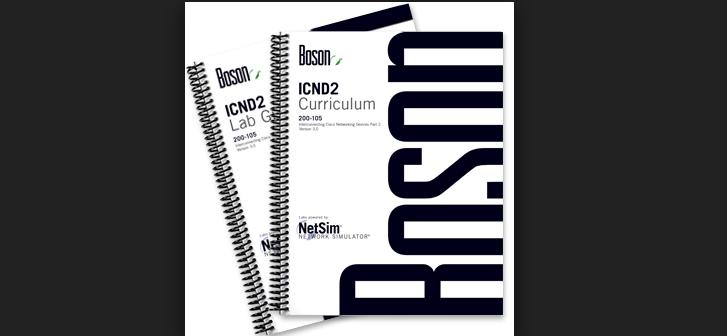
Question No : 8 – (Topic 1) Refer to the exhibit.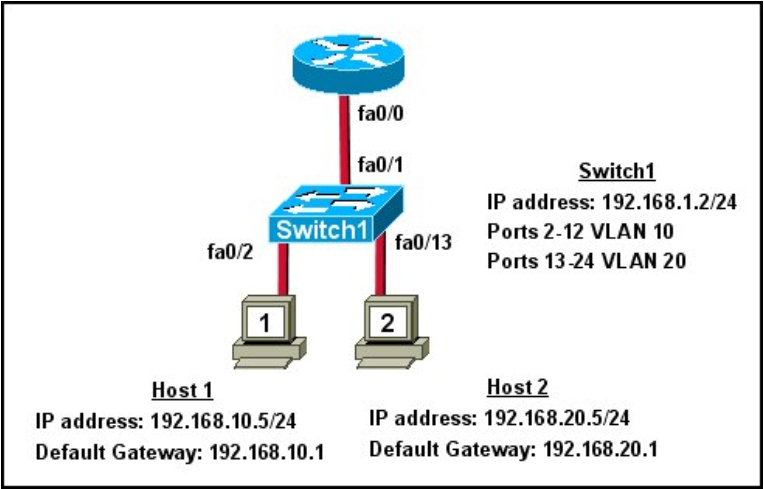
What commands must be configured on the 2950 switch and the router to a
communication between host 1 and host 2? (Choose two.)
A. Router(config)# interface fastethernet 0/0
Router(config-if)# ip address 192.168.1.1 255.255.255.0
Router(config-if)# no shut down
B. Router(config)# interface fastethernet 0/0
Router(config-if)# no shut down
Router(config)# interface fastethernet 0/0.1
Router(config-subif)# encapsulation dot1q 10
Router(config-subif)# ip address 192.168.10.1 255.255.255.0
Router(config)# interface fastethernet 0/0.2
Router(config-subif)# encapsulation dot1q 20
Router(config-subif)# ip address 192.168.20.1 255.255.255.0
C. Router(config)# router eigrp 100
Router(config-router)# network 192.168.10.0
Router(config-router)# network 192.168.20.0
D. Switch1(config)# vlan database
Switch1(config-vlan)# vtp domain XYZ
Switch1(config-vlan)# vtp server
E. Switch1(config)# interface fastethernet 0/1
Switch1(config-if)# switchport mode trunk
F. Switch1(config)# interface vlan 1
Switch1(config-if)# ip default-gateway 192.168.1.1
Answer: B,E
Explanation: The two answers B and E list all the commands needed to configure interVLAN routing.
Please notice that Cisco switch 2950, 2960 only support dot1Q trunking so we don’t need
to specify which trunking encapsulation to use in this case. For Cisco switches 3550 or
above we have to use these commands instead:
Switch3550(config-if)#switchport trunk encapsulation dot1q
Switch3550(config-if)#switchport mode trunk
Question No : 9 – (Topic 1) Which two of these statements regarding RSTP are correct? (Choose two.)
A. RSTP cannot operate with PVST+.
B. RSTP defines new port roles.
C. RSTP defines no new port states.
D. RSTP is a proprietary implementation of IEEE 802.1D STP.
E. RSTP is compatible with the original IEEE 802.1D STP.
Answer: B,E
Explanation:
http://www.cisco.com/en/US/tech/tk389/tk621/technologies_white_paper09186a0080094cf
a.shtml
Port Roles
The role is now a variable assigned to a given port. The root port and designated port roles
remain, while the blocking port role is split into the backup and alternate port roles. The
Spanning Tree Algorithm (STA) determines the role of a port based on Bridge Protocol
Data Units (BPDUs). In order to simplify matters, the thing to remember about a BPDU is
there is always a method to compare any two of them and decide whether one is more
useful than the other. This is based on the value stored in the BPDU and occasionally on
the port on which they are received. This considered, the information in this section explains practical approaches to port roles.
Compatibility with 802.1D
RSTP is able to interoperate with legacy STP protocols. However, it is important to note
that the inherent fast convergence benefits of 802.1w are lost when it interacts with legacy
bridges.
Question No : 10 – (Topic 1) Refer to the exhibit.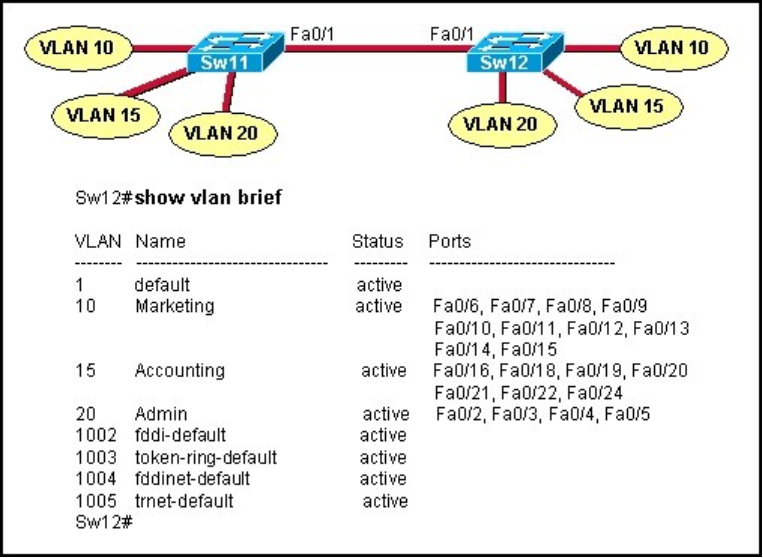
A technician has configured the FastEthernet 0/1 interface on Sw11 as an access link in
VLAN 1. Based on the output from the show vlan brief command issued on Sw12, what will
be the result of making this change on Sw11?
A. Only the hosts in VLAN 1 on the two switches will be able to communicate with each
other.
B. The hosts in all VLANs on the two switches will be able to communicate with each other.
C. Only the hosts in VLAN 10 and VLAN 15 on the two switches will be able to
communicate with each other.
D. Hosts will not be able to communicate between the two switches.
Answer: D
Explanation:
VLANs are local to each switch’s database, and VLAN information is not passed between
switches without implementing VLAN Trunk Protocol (VTP). Trunks carry traffic from all
VLANs to and from the switch by default but, can be configured to carry only specified
VLAN traffic. Trunk links are required to pass VLAN information between switches. So
Sw11 port should be trunk not access port. Additionally, there are no ports assigned to
VLAN 1.
Question No : 11 – (Topic 1) What are two characteristics of a switch that is configured as a VTP client? (Choose two.)
A. If a switch that is configured to operate in client mode cannot access a VTP server, then
the switch reverts to transparent mode.
B. On switches that are configured to operate in client mode, VLANs can be created,
deleted, or renamed locally.
C. The local VLAN configuration is updated only when an update that has a higher
configuration revision number is received.
D. VTP advertisements are not forwarded to neighboring switches that are configured in
VTP transparent mode.
E. VTP client is the default VTP mode.
F. When switches in VTP client mode are rebooted, they send a VTP advertisement
request to the VTP servers.
Answer: C,F
Explanation:
VLAN Trunking Protocol (VTP)
http://archive.networknewz.com/2004/0317.html
VTP Modes
Server Mode Once VTP is configured on a Cisco switch, the default mode used is Server
Mode. In any given VTP management domain, at least one switch must be in Server Mode.
When in Server Mode, a switch can be used to add, delete, and modify VLANs, and this
information will be passed to all other switches in the VTP management domain. Client Mode When a switch is configured to use VTP Client Mode, it is simply the recipient
of any VLANs added, deleted, or modified by a switch in Server Mode within the same
management domain. A switch in VTP client mode cannot make any changes to VLAN
information.
Transparent Mode A switch in VTP Transparent Mode will pass VTP updates received by
switches in Server Mode to other switches in the VTP management domain, but will not
actually process the contents of these messages. When individual VLANs are added,
deleted, or modified on a switch running in transparent mode, the changes are local to that
particular switch only, and are not passed to other switches in the VTP management
domain.
Question No : 12 – (Topic 1) Which term describes a spanning-tree network that has all switch ports in either the
blocking or fowarding state?
A. converged
B. redundant
C. provisioned
D. spanned
Answer: A
Explanation: 200-105 dumps
Spanning Tree Protocol convergence (Layer 2 convergence) happens when bridges and
switches have transitioned to either the forwarding or blocking state. When layer 2 is
converged, root bridge is elected and all port roles (Root, Designated and Non-Designated)
in all switches are selected.
Question No : 13 – (Topic 1) Refer to the exhibit.

Given the output shown from this Cisco Catalyst 2950, what is the reason that interface
FastEthernet 0/10 is not the root port for VLAN 2?
A. This switch has more than one interface connected to the root network segment in
VLAN 2.
B. This switch is running RSTP while the elected designated switch is running 802.1d
Spanning Tree.
C. This switch interface has a higher path cost to the root bridge than another in the
topology.
D. This switch has a lower bridge ID for VLAN 2 than the elected designated switch.
Answer: C
Explanation: These four parameters are examined in order to make root bridge , root port ,
designated port. Other switch has lowest Sending Bridge ID or Sending Port ID so vlan 2 is
not the root port.
1. A lower Root Bridge ID2. A lower path cost to the Root3. A lower Sending Bridge ID4. A
lower Sending Port ID
Question No : 14 – (Topic 1) Refer to the exhibit.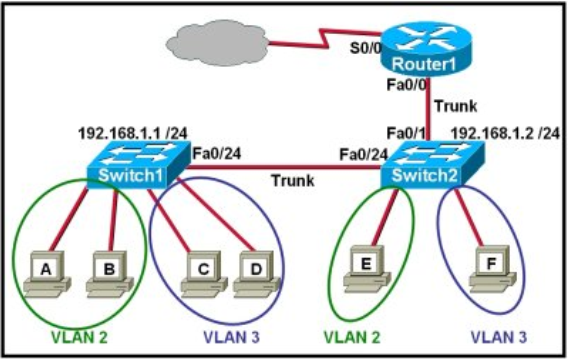
Which two statements are true about interVLAN routing in the topology that is shown in the
exhibit? (Choose two.)
A. Host E and host F use the same IP gateway address.
B. Router1 and Switch2 should be connected via a crossover cable.
C. Router1 will not play a role in communications between host A and host D.
D. The FastEthernet 0/0 interface on Router1 must be configured with subinterfaces.
E. Router1 needs more LAN interfaces to accommodate the VLANs that are shown in the
exhibit.
F. The FastEthernet 0/0 interface on Router1 and the FastEthernet 0/1 interface on
Switch2 trunk ports must be configured using the same encapsulation type.
Answer: D,F
Explanation:
Question No : 15 – (Topic 1) Refer to the exhibit
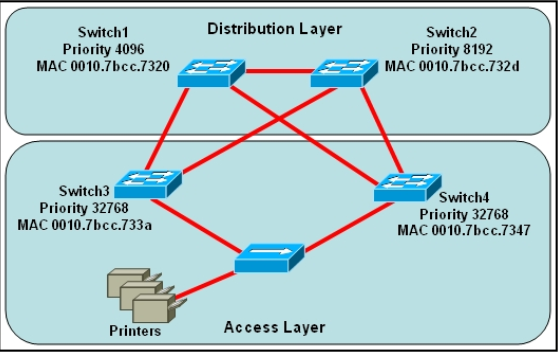
Which switch provides the spanning-tree designated port role for the network segment that
services the printers?
A. Switch1
B. Switch2
C. Switch3
D. Switch4
Answer: C
Explanation:
First, the question asks what switch services the printers, so it can be Switch 3 or Switch 4
which is connected directly to the Printers.
Designated port is a port that is in the forwarding state. All ports of the root bridge are
designated ports.
Switch 3 and Switch 4 has same priority so it will see on lowest MAC address and here
switch 3 has lowest MAC address. So switch 3 segment will play a Designated port role.
By comparing the MAC address of Switch 3 and Switch 4 we found that the MAC of Switch
3 is smaller. Therefore the interface connected to the Printers of Switch 3 will become
designated interface and the interface of Switch 4 will be blocked
Question No : 16 – (Topic 1) Which protocol provides a method of sharing VLAN configuration information between two
Cisco switches?
A. STP
B. VTP
C. 802.1Q
D. RSTP
Answer: B
Explanation:
Understanding VLAN Trunk Protocol (VTP)
http://www.cisco.com/en/US/tech/tk389/tk689/technologies_tech_note09186a0080094c52.
shtml
Introduction
VLAN Trunk Protocol (VTP) reduces administration in a switched network. When you
configure a new VLAN on one VTP server, the VLAN is distributed through all switches in
the domain. This reduces the need to configure the same VLAN everywhere. VTP is a
Cisco-proprietary protocol that is available on most of the Cisco Catalyst series products.
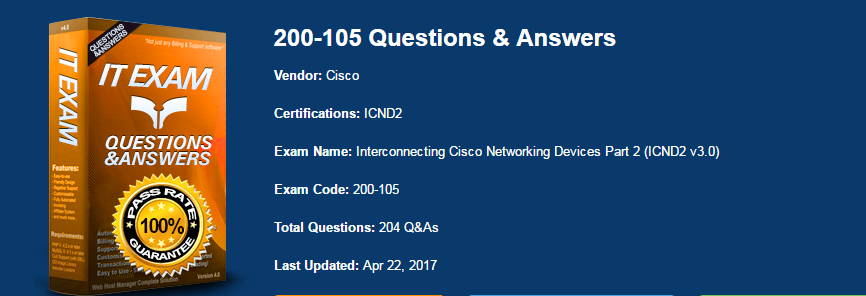
The Interconnecting Cisco Networking Devices Part 2 (200-105 ICND2) 200-105 dumps exam is a 90-minute, 45–55 question assessment that is associated with the associated with the CCNA Routing and Switching certification. This exam tests a candidate’s knowledge and skills related to LAN switching technologies, IPv4 and IPv6 routing technologies, WAN technologies, infrastructure services, and infrastructure maintenance.
The 200-105 dumps following topics are general guidelines for the content likely to be included on the exam. However, other related topics may also appear on any specific delivery of the exam. In order to better reflect the contents of the exam and for clarity purposes, the guidelines below may change at any time without notice.
Strongly Recommended: http://www.leads4pass.com/200-105.html
Official Site:http://www.cisco.com/c/en/us/training-events/training-certifications/exams/current-list/200-105-icnd2.html
